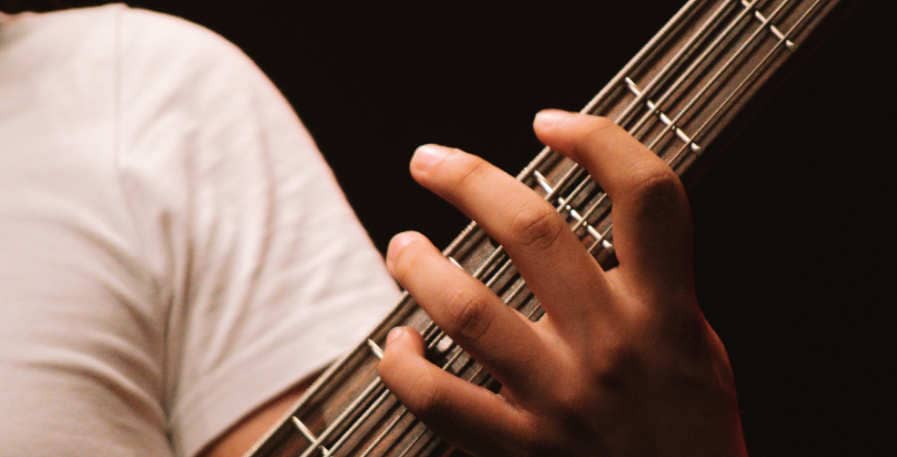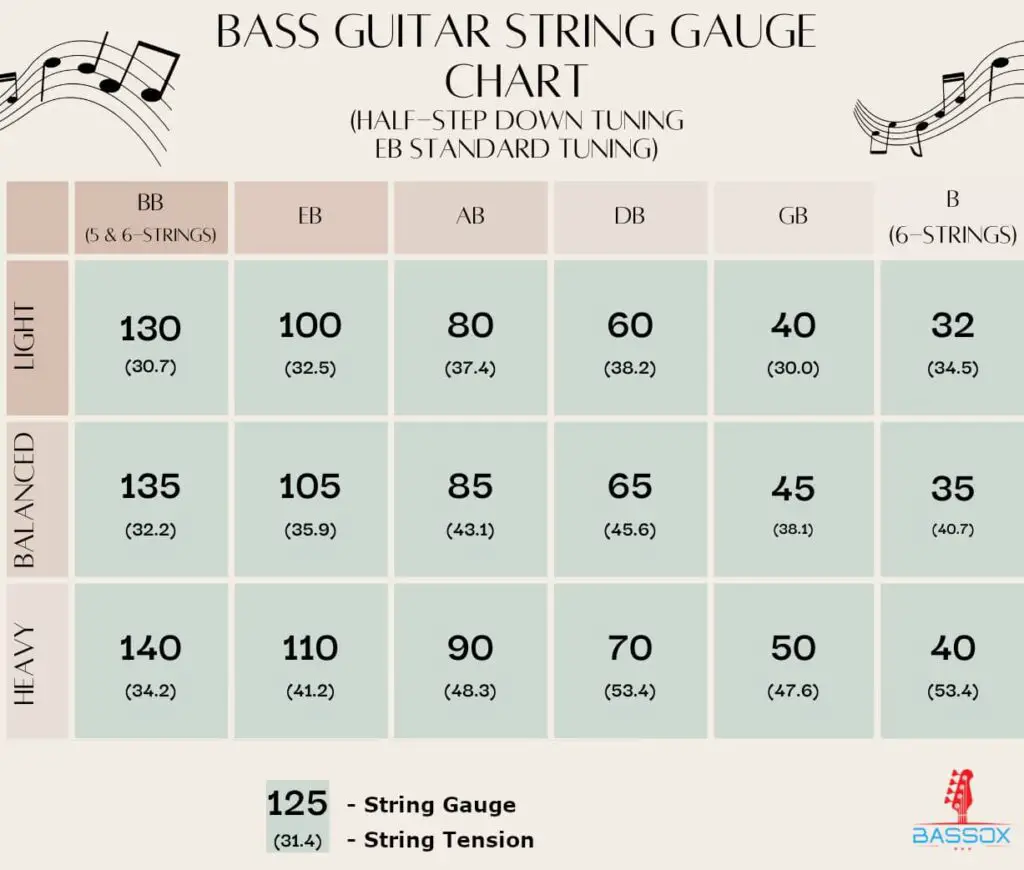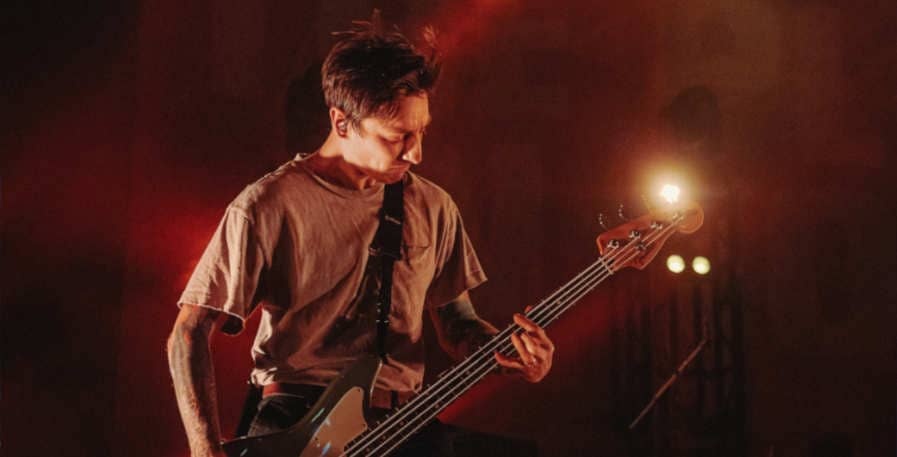This post contains affiliate links
Eb standard is a bass tuning with many different names. Depending on who you ask, they will call it half-step down, D# standard, or the Hendrix tuning. While this can cause some confusion, they are really talking about the same tuning.
The tuning also has as many uses as it has names. Bassists have tuned their instruments down half a step in everything from pop to heavy metal. Eb has also been used for a multitude of purposes, such as sounding heavier, accommodating the vocalist, and for the sake of variety.
There are however some things you need to be mindful of when tuning your bass a half step down. That`s why I`ve written this guide to tell you everything you need to know about Eb standard. I will show you what tuning to Eb means, and I`ve made a tuner so that you can easily tune down to it.
Below you will also find a list of the most common reasons musicians choose this tuning, and what strings suit it the best. You can use this information to find out whether tuning your bass a half step down is right for you, and what the pros and cons of doing so are.
What does tuning to Eb mean?
Tuning a bass to Eb means that the strings are tuned a half step down. On 4 string basses, this means that the strings are tuned Eb-Ab-Db-Gb. A 5-string bass tuned to Eb is tuned to Eb-Ab-Db-Gb-B, but tuning to a Bb-Eb-Ab-Db-Gb is often more convenient.
When you tune down to Eb, you are sacrificing 1 half-step of high range for 1 additional half-step of deep range. For most bassists, losing 1 half-step of high range is insignificant. Gaining a half-step of deep range can however make a big difference in what types of basslines you can play.
Half-step down is a convenient tuning to play in and for making use of your built-up muscle memory. This is because it is a standard tuning.
This means that every string is tuned a perfect fourth apart just like in E standard. As a result, you can play all basslines that are written for E in Eb as well. They will be in a different key, but they will still sound harmonious. You can also play them in their original key by playing 1 fret higher up.
A bass tuned a half step down is referred to as both D# standard, and Eb standard. The difference briefly explained, is simply that D# and Eb have different functions depending on their musical context.
If you are interested in the theory behind it, there are great resources on the difference between flats and sharps out there. For tuning purposes, it is however not something you need to pay any mind to.

Why do bands play in E flat?
Eb, or D# Standard has been used by artists in a wide range of genres. Thus, it comes as no surprise that bands and artists opt for this tuning for a wide range of reasons. Here are the most common ones:
Heaviness and punch
While E Flat only provides a half-step of deeper range, this can still lead to a significantly punchier and heavier sound.
Because E standard is so commonly used, this slight change in pitch will make a band sound discernably heavier. It is however not excessively heavy, which makes it a versatile tuning that has been used by vastly different bands.
Eb standard has been used by Weezer and Green Day to add a bit of extra punch to their sound. It has also been used by heavier bands such as Pantera and Slayer to dish out heavy metal riffs. Thus, it is a great tuning for bands that want to sound heavy but don`t want to go overboard.
Sweet-spot
Many bands find that the slight change in pitch hits a sweet spot. It allows them to sound heavier, but not without deviating from their core sound, or alienating a mainstream audience.
Great examples of this are Micheal Jackson and Simon and Garfunkel who have utilized E Flat on occasion.
Tuning to Drop A would be an unfit and awkward choice for these artists. Eb Standard, on the other hand, hits a sweet spot where a pop or folk act can sound heavier, while still sounding like themselves.
Accommodating the vocalist
Playing songs at a deeper pitch can be helpful for vocalists who have a naturally deep voice, or who have lost some of their range from aging.
While every alternate tuning can be used to help out the vocalist, E Flat is a common choice for this purpose. This is because the additional half-step of low range is often enough to make a big enough difference for the vocalist.
“And so a lot of my riffs were in E-flat, and I guess when James would hear the riffs tuned in E-flat and he’d try to sing to ’em, I think he kind of liked it. He liked the break it kind of gave his voice. He didn’t have to pitch that extra half step.”
Kirk Hammet of Metallica on tuning to E-Flat during the recording of “Load” – “A Conversation About Load” From Metallica.com
This tuning also alters the sound of a song written in E less than tuning to a deeper tuning such as C# standard. Thus, it is a great choice when you need to tune down, but don`t want to alter the sound of the song too much.
Convenience
Most alternate tunings require a good bit of setup to sound good and be playable.
While switching from E standard to C standard during a live show is possible, it would leave you with loose strings, an instrument that is harder to play, and a tone that is clanky and unresonant.
This is however not the case with E Flat standard. If you tune down during a concert, you will still get a good tone out of your bass and the strings will be playable despite being slightly looser.
Thus, it is a convenient tuning, as you can quickly and easily switch between it and E Standard. This makes it more effective during rehearsals and doesn`t require you to bring multiple basses to a live show.
How to tune a bass down 1/2 step
A bass guitar can be tuned down 1/2 step either with the help of a physical or an online tuner. Alternatively, you can use a piano or a different instrument to match the pitch of your strings to Eb-Ab-Db-Gb.
To make tuning down easy for you, I have made an Eb tuner that you can use below.
For 4-string players, simply use the first 4 pitches below to tune to Eb-Ab-Db-Gb.
5-string players, I personally recommend tuning to Bb-Eb-Ab-Db-Gb. This is technically a Bb standard tuning, but it is significantly more convenient than tuning up to Eb-Ab-Db-Gb-B. The latter requires you to set up your bass with lighter strings and is redundant unless you`re looking for additional high range.
Related reading: Average cost of bass setup.
For 6-string players, I recommend tuning to Bb-Eb-Ab-Db-B. This is also a Bb standard but will give you more than enough deep and high range to bother setting up your bass specifically for Eb.
Eb1: (Deepest string on 4-string basses)
Ab1:
Db2:
Gb2: (Highest string on 4 string basses)
Use the pitch below for tuning your highest string to B if you are looking to tune a 5-string bass to Eb-Ab-Db-Gb-B, or a 6-string bass to Bb-Eb-Ab-Db-Gb-B.
B2:
Use the pitch below to tune your deepest string down for a Bb-Eb-Ab-Db-Gb tuning on a 5-string bass, or a Bb-Eb-Ab-Db-Gb-B tuning on a 6 string bass.
Bb0:
If you struggle to match the pitch, you can also use an online bass tuner with a microphone. This will show you exactly what pitch is being played at all times, which ensures that your bass ends up perfectly in tune.

What bass strings to choose for E Flat?
A regular gauge set such as .105-.045 can be tuned down to E Flat without issue. It is possible to opt for a slightly heavier set such as .110-.050 to attain a heavier tone, and it is inadvisable to tune down extra light strings.
For a regular set of bass strings, tuning down a half-step will not have a significant enough effect on the tension and playability of the strings to make much of a difference. Thus, while most alternate tunings will sound poor without a string change, this is rarely an issue with Eb.
With that said, if you tune down and find that your tone isn`t heavy enough, switching to slightly heavier strings could improve your sound. You can learn more about this in my bass string gauge chart. For the short version, here`s a chart of string tensions for Eb:

If you are looking to play rock or metal, I recommend using roundwound strings for their bright tone. Flatwound strings have their place, but they are not a good fit if you are looking for a heavy tone.
Therefore, if you are currently tuned to E, my recommendation is to try tuning down your current set. If you find that the strings are too loose or not resonant enough, consider switching to a 66 Rotosound .110-.050 roundwound set.
What bands use Eb tuning?
While Eb has been used across a wide range of genres, the tuning is most common in rock and metal. Within these genres, everything from heavy thrash metal bands, to more commercial rock acts have tuned a half-step down.
Below are some noteworthy bands and bassists that have made use of Eb standard. Notice how versatile the list is and how Eb can be used for practically any purpose within these genres:
| Band | Bassist | Genre | Notable songs in Eb tuning |
| Guns N` Roses | Duff McKagan | Rock | November Rain, Sweet Child O`Mine |
| Thin Lizzy | Phil Lynott (1969–1983), Troy Sanders* (2019 onward, *touring member) | Hard Rock | The Boys Are Back In Town, Jailbreak |
| Slayer | Tom Araya | Thrash Metal | Raining Blood, Seasons In The Abyss |
| Weezer | Matt Sharp (1992-1998), Scott Shriner (2001 onward) | Alt-Rock | The Good Life, Say it Ain`t So |
| Metallica | Multiple. Jason Newsted when Eb was prominently used. | Metal | The Memory Remains, Until it Sleeps |
| Green Day | Mike Dirnt | Punk-Rock | Basket Case, Welcome To Paradise |
| Alice In Chains | Mike Starr (1987-1993), Mike Inez (1993 onward) | Grunge | Would?, Got Me Wrong |
| Pantera | Rex Brown | Metal | This Love, Regular People |
| Puddle Of Mudd | Various. Michael John Adams (2014 onward) | Rock | She Hates Me, Blurry |
| Van Halen | Michael Anthony (1974-2006), Wolfgang Van Halen (2006 onward) | Rock | Ain’t Talkin Bout Love, Eruption |
Conclusion
Tuning your bass a half-step down is the best way to dive into the world of alternative bass tunings. It is convenient and easy to tune to, but can still greatly alter both your own sound and the sound of your band.
It`s a great tuning for sounding heavier and to avoid the cliche of writing too many songs in E and A. This can assist in making you stand out, make your live shows more impactful, and makes you a more diverse songwriter.
Eb standard is a bass tuning that requires minimal setup. Unless you are using super thin strings already, you can merely tune down any set intended for E standard without issue. If you are going for heaviness, you can opt for a slightly heavier set of strings to further elevate your sound.
That`s all there is to it. Use the tuner above to get started and plug your bass in. Chances are that you will be amazed at how much of a difference a half-step can, and how much this can elevate and diversify your sound.
Eb standard is one of two alternate bass tunings that are convenient to tune to and us thus great options for beginners. The other is Drop D. If you want to learn more about why, and what the advantages of this tuning are, I`ve made a guide and a tuner for Drop D as well.

